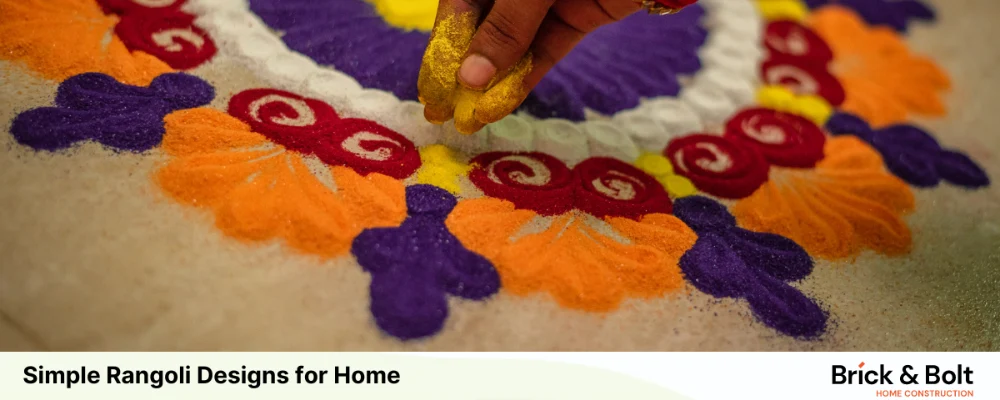Rangoli is a traditional form of art that includes the creation of patterns and designs on the ground with the help of various materials, mainly colour powders. This traditional practice is a part of Indian culture that has been used for over centuries. This has been used in various festivals, celebrations, and religious occasions. Rangoli is a variety of colours that can form a vibrant and beautiful design.
This blog will provide you with information regarding the rangoli, the need for simple designs, and the types of simple design rangoli that can be used for home.
What is Rangoli?
Rangoli is an art form that originated from the Indian subcontinent, and these forms are created by using materials like limestone, dry rice flour, quartz powder, flower petals, coloured rocks, and red ochre. This is a tradition that is practiced every day in many Hindu houses; however, mostly they are reserved for festivals and important celebrations as it is time-consuming.
Rangoli designs can be simple geometric shapes, structures of deities, flowers, or flower petals that are created for given celebrations. These designs can also be drawn on a daily basis for home decoration.
Why is it Needed for Simple Designs?
Rangoli designs can be elaborated during major festivals and special occasions, but simple designs have their own charm and practicality. Simple rangoli designs are easy to create and also provide more accessibility to beginners and people who have busy lifestyles. They need a smaller amount of materials and a small amount of time, and they are also perfect for the visuals of the home.
By selecting a simple design, you can enjoy the process of rangoli creation without any pressure to get a perfect result. It will be easier to experiment with different patterns and styles that can help you develop your artistic skills over a period of time. Along with that, simple rangoli designs are versatile and can be used for different occasions, which makes them convenient and beautiful along with your home decorations.
Getting Started with Rangoli
Materials Required
Before starting the rangoli, it is important to gather all the necessary items. Some of them include,
- Colour powders
- Rice flour
- Stencils
- Flowers and petals
- Chakar white pencil
- Oil lamps
Selection of the right spot
Selecting the correct place to draw your rangoli is very important. This can help in improving the overall appearance of the design. Commonly, rangoli is created at the home entrance, courtyards, or near any sacred places like altars or pooja rooms. Normally the popular choice for rangoli is the entrance of the home, as it symbolises the welcoming of guests and deities with positive energy and good fortune.
In modern homes, when choosing a spot for rangoli, it is good to consider the areas that are visible and well-lit. The good choices will be the living room, balcony, or a space that is near the main door. Before starting the rangoli, make sure that the surface is clean, flat, and dry. If the rangoli is drawn indoors, then go for the spot that has minimum foot traffic to avoid any accidental smudging.
Basic Rangoli Patterns
Dot rangoli
Dot rangoli is mainly involved in creating designs by using small dots. Dots will be placed in a specific pattern to form shapes, flowers, or any animals. It is one of the simplest and most traditional forms of Rangoli. The term involves the creation of a group of dots and then connecting them with the lines or curves to form different patterns.
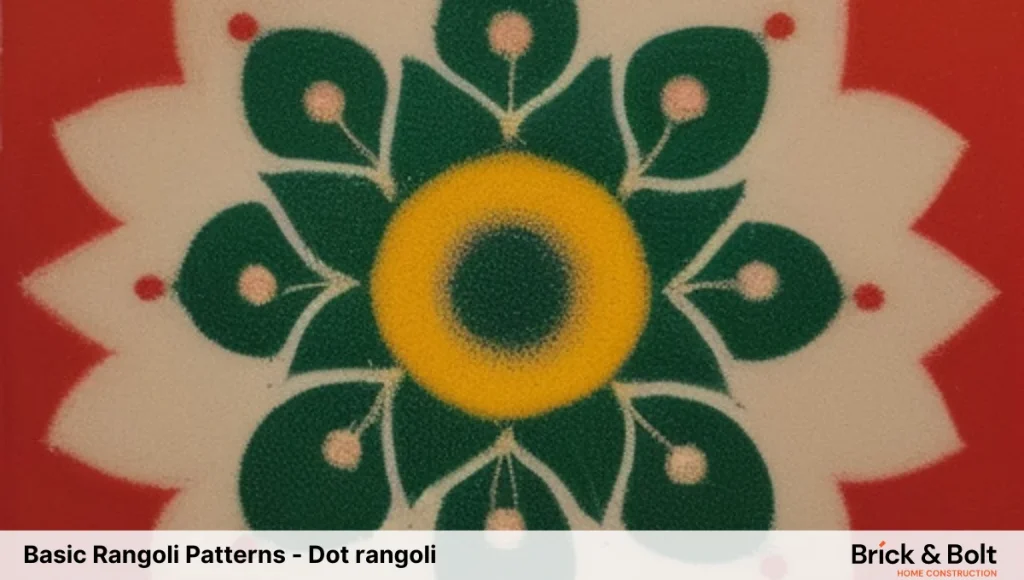
Some of the steps involved are,
- Draw a grid of dots.
- Connect the dots.
- Fill it with the colours.
Beginners can start with some basic patterns, like simple flowers and stars. After a certain amount of experience, you can start trying more complex designs.
Geometric Rangoli
Geometric rangoli mainly uses shapes like squares, circles, triangles, and diamonds as their base. They are easy to draw and can be combined with different ways of creating innovative patterns. They mainly represent the cosmic order and harmony. The shapes can be combined to produce intrinsic patterns that have symmetry, making them perfect for simple rangoli design.
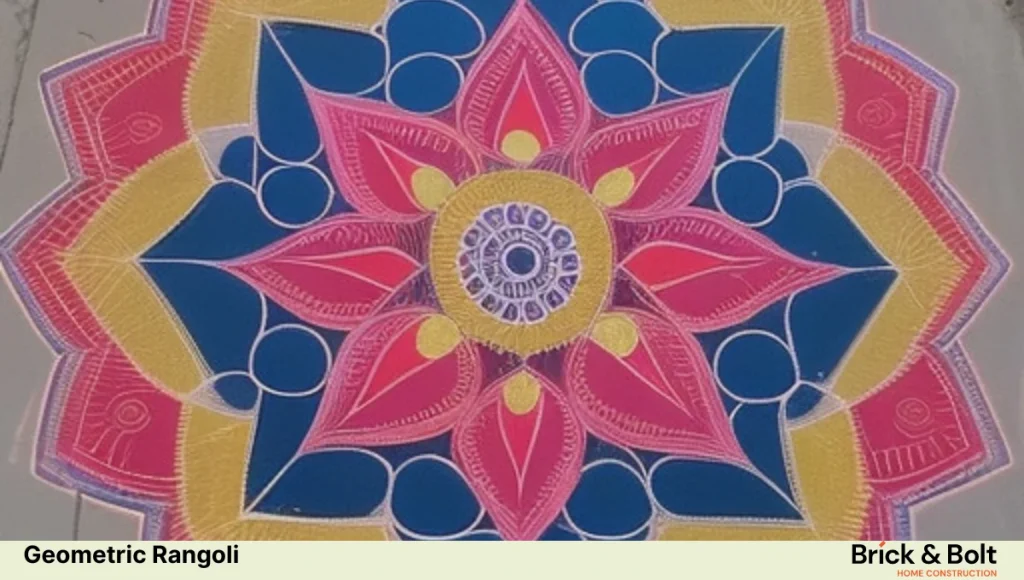
Some of the easy patterns are,
- Concentric squares can be drawn, and alternating colours can be filled in each square.
- A series of circles can be drawn, and they can be decorated with different colours and patterns.
- Starlike patterns or other symmetrical designs can be made by using triangles.
Freehand Rangoli
Free-hand rangoli is created without any guidelines or measurements. These types of designs are drawn with the imagination of the artist directly on the floor. This style will improve the creativity and spontaneous thinking of the artist, making it easier for the rangoli designers who are beginners.
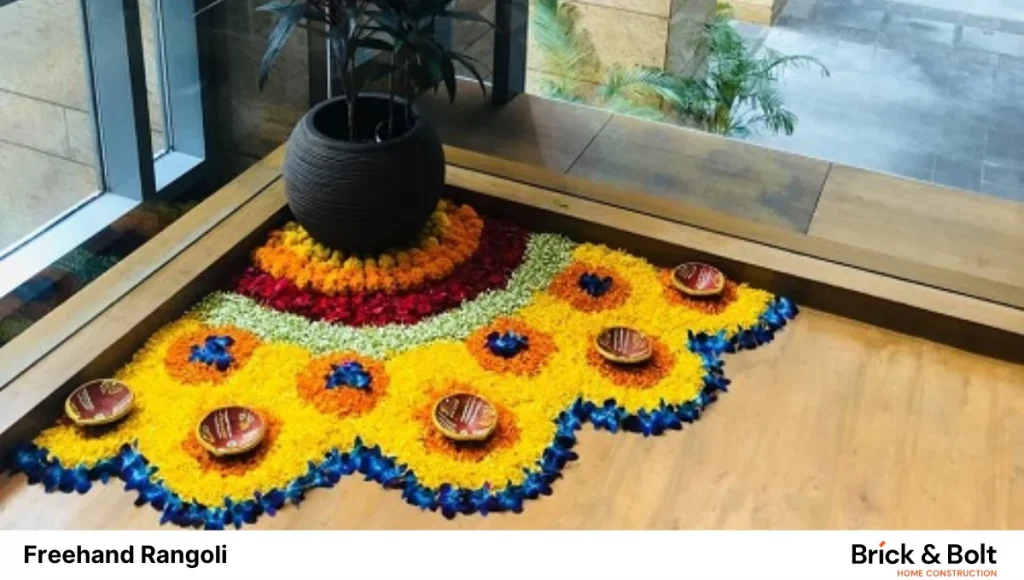
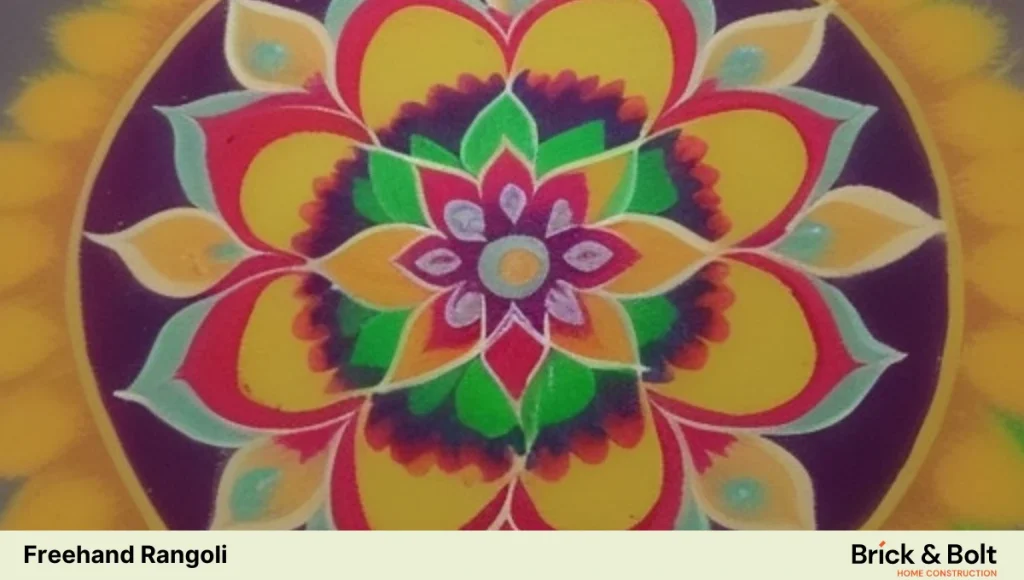
Some of the basics of freehand drawings are that you can start with a central design like flowers and expand it outwards. Here you can use your creativity for drawings or any swirls and other decorating elements. The simple design for free-hand rangoli may range from simple floral patterns to more elaborate designs. The important part is to maintain the symmetry and balance in the design.
Creative Ideas for Simple Rangoli
Floral Rangoli
Floral Rangoli mainly uses natural elements like flower petals and leaves to create a beautiful and eco-friendly design. This type of design will be frequently used during festivals like Onam and Diwali, where fresh flowers are mostly available.
Flower petals and leaves can be collected from various types of flowers like roses, chrysanthemums, and marigolds. These flowers will be arranged in a pattern on the floor, starting from the center and working outwards. Leaves can be added to provide a green colour contrast.
The flower petals can be mixed with traditional rangoli powders that can provide a variety to your design.
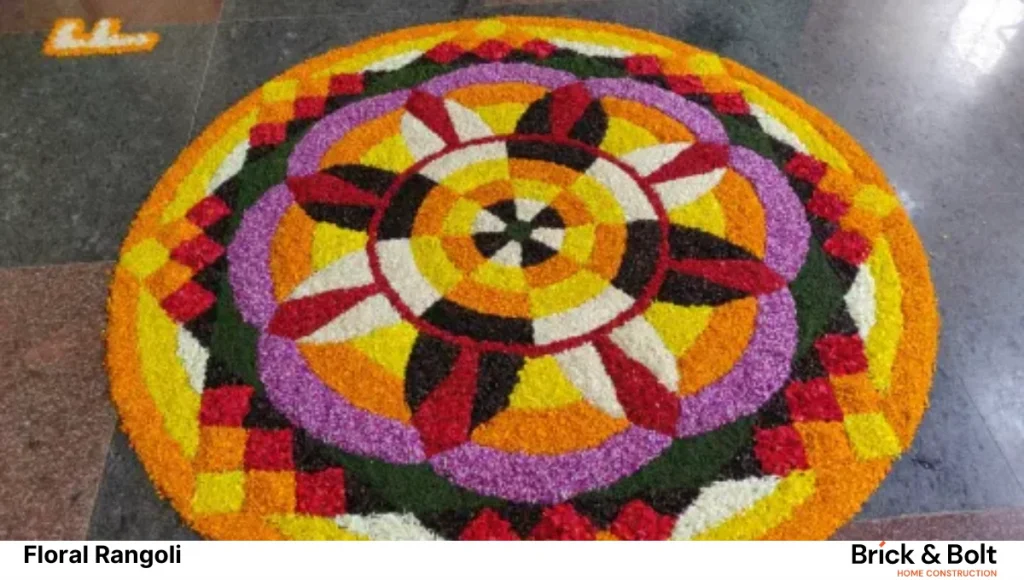
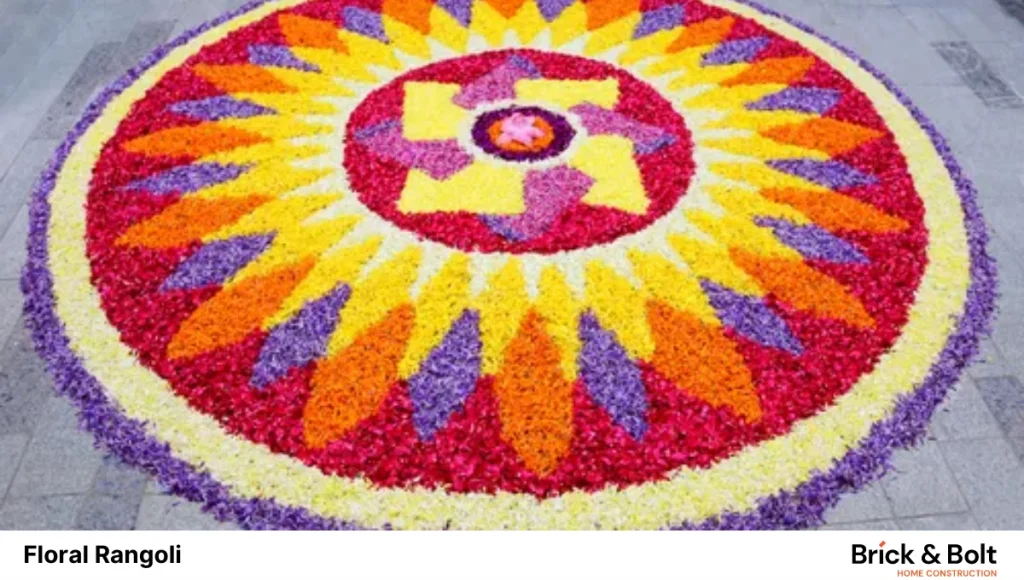
Stencil Rangoli
Stencil Rangoli can be used to create more intrinsic designs easily and quickly. These are precut templates that can be used on the floor, and Rangoli powder can be used to fill the gaps. They are available in different designs, from simple shapes to complex patterns.
The steps involved in using stencil Rangoli are,
- Selection of stencil design
- The stem cell needs to be placed on the floor where the rangoli needs to be made.
- Gently fill the stencil with their rangoli powder, making sure that all the areas are covered evenly.
- Carefully lift the stencil.
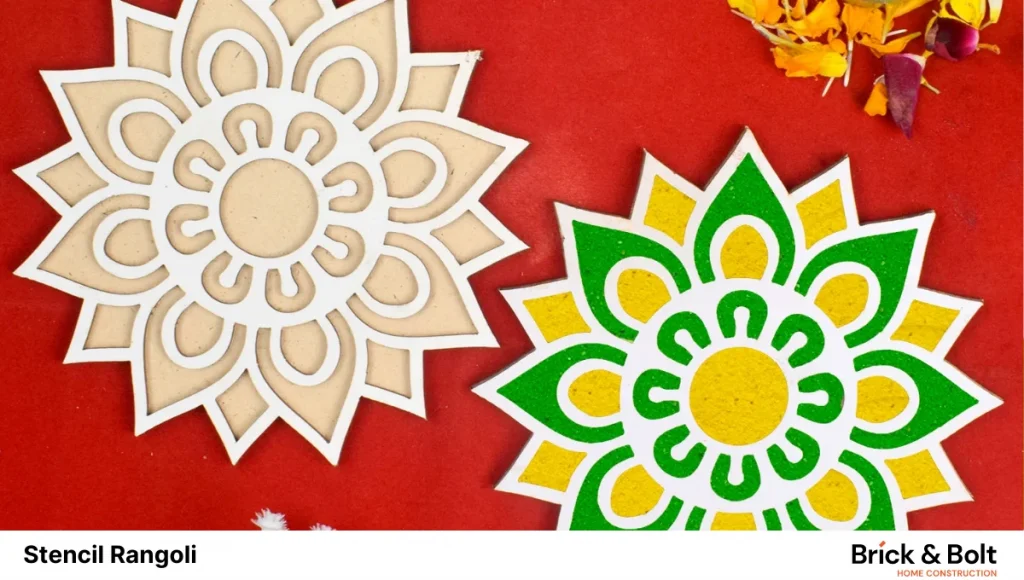
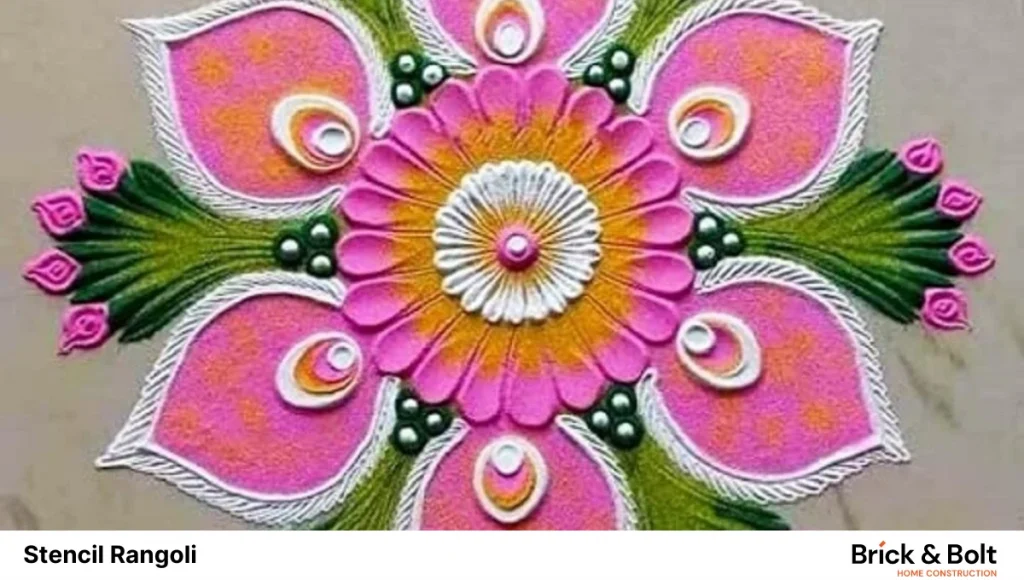
Conclusion
Rangoli can be considered more than a decorative work as it is used in the celebration of culture, improving creativity and providing happiness by making something creative and beautiful with your own hands. Rangolis can be used daily or occasionally. Yet simple designs can help provide a beautiful look and also include the traditions of life in this fast-paced era.
FAQs
Yes, Rangoli can be created daily, especially simple designs that don’t require much time or materials. Many people make small, easy patterns at their doorsteps each morning to start the day on a positive note.
Basic materials include coloured powders, rice flour, and stencils. You can also use flower petals, leaves, and even small diyas for added creativity.
Freehand drawing allows you to create unique designs using your creativity. Start with basic shapes or a central motif, and build your design outward, focusing on symmetry and balance.
Definitely! Simple designs are a great way to introduce children to Rangoli. They can help with filling in colors, arranging flower petals, or using stencils to create patterns.
You can incorporate contemporary patterns, use unusual colour schemes, or even try creating Rangoli on water using floating diyas and flowers. Mixing traditional with modern elements can create unique designs.

